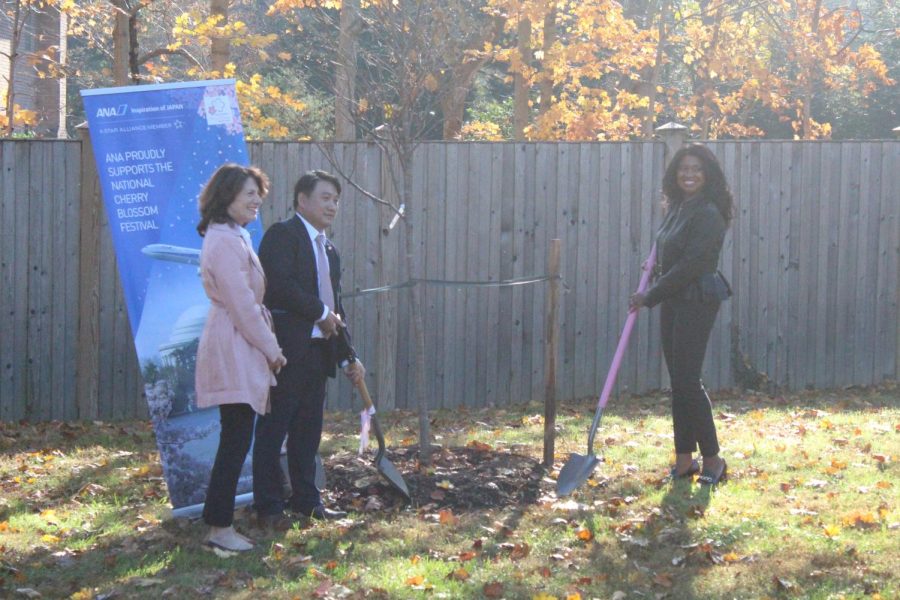The Season of Blossoms
A look into the newly planted cherry blossoms at Langley
A group of students are huddled together under bare trees as dead leaves fall on their backpacks, listening to Andrew Scronce, a Japanese teacher or Scronce-sensei, give a speech among ANA Japanese Airline Representatives. Three trees, slightly shorter than most of the students, are planted beside them, cherry trees yet to bloom. Kimberly Greer, Langley’s principal addresses the students, congratulating them on their adherence to their studies of the language that contributes to the large and thriving Japanese program at Langley. The members of the airline that gifted Langley these cherry trees also give their individual speeches, a mixture of Japanese and English.
This gift is not one without meaning. Cherry blossoms are a significant part of Japanese culture, and whether or not they are given or received, both actions have meanings that are beyond only bestowing someone with a tree.
“…There’s a cultural relevance in Cherry blossoms, it’s seen historically as a beautiful flower,” junior Jayce Walton said. “…it definitely has to do with historical relevance, and Japan has a very historically oriented culture.”
As such, Cherry trees have deep historical roots. In 1912, to signify a blossoming of American and Japanese relations, they were given to Washington DC, where they remain, blooming every spring and bringing thousands of visitors flocking to the nation’s capital. The cherry trees recently planted here at Langley mirror this historical event, as they represent the thriving Japanese program here at Langley and the international flair of the school.
The man at the center of this growth of the Japanese program at Langley is Andrew Scronce, who has been teaching Japanese for 16 years. He started learning the language after a simple curiosity about the culture, but eventually found the language beautiful and the culture equally beautiful as well.
“I’ve been studying Japanese for so long I find it pretty enjoyable,” Andrew Scronce said. “[It’s] nice that I can listen to a Japanese person’s Japanese, and I appreciate that.”
This enthusiasm for the language does not go unnoticed by his students.
“Scronce-sensei makes the classes very fun, he tries to introduce activities and projects are the main part of your grade,” Walton said.
His character as a teacher and ability to understand his students well has many far-reaching impacts. As a result, Scronce has also inspired many students to learn Japanese as well.
“I was really inspired by the teacher himself to learn Japanese. “ Langley senior Thomas Warden said. “He’s just super nice and super caring, and I feel like if the teacher was anyone else, I wouldn’t love Japanese the way that I do.”
Part of his success is his ability to marry aspects of both American and Japanese culture. Because Japanese culture is extremely different from American culture, Scronce has a duty to take both into account when conducting and speaking at ceremonies where Japan and America come into contact like this.
“It was a little bit tricky today,” Scronce said. “If we were in Japan, they would want the ceremony to be very formal, with microphones and introductions and speeches…in America, ceremonies are not so important, so it’s a little bit more informal. [But] I think it worked out well, and we had a good mix of both.”
Scronce is also well informed about the opportunities that lie ahead of Langley students as a result of their Japanese language education. Instead of learning Japanese just to do good in the classes, the language skills students learn can be applied after high school.
“If a Japanese company needs somebody that speaks English, they’re gonna hire somebody from America that knows Japanese,” Scronce said. “It’s a great opportunity if you learn the Japanese language, you can go work in Japan and live in Japan, which can’t really be said for the other languages students take.”
Part of his advice for new students that learn Japanese is to seek professional help from teachers in order to learn the language thoroughly. As Japanese is such a complex language, it can prove difficult for many students to self learn, and online resources will only get them so far.
“While you can do a bit of self-study, you’re probably better off taking it as a language at school, or getting a tutor, or working with somebody.” Scronce said. “…Langley students are so lucky they get to take a language like Japanese. They’re not many high schools that have Japanese at their school.”
When asked about what interested him about Japanese, it was the culture that caught his attention the most. Japanese culture is full of many extensive components that differ from the stereotypical straightforward culture that America is known for.
“I learned Japanese because I had a lot of questions about Japan. I wanted to know why you took off your shoes when you went into the house, why you put on a different pair of shoes when you entered into the bathroom, why Japanese people don’t eat the outside of the grape,” Scronce said. “All of those things were interesting to me, and I wanted to learn Japanese so I could ask Japanese people those questions. I like to teach my students the answers to those questions too, and it makes it really interesting for them in their language learning.”


